You can get cool results when photographing water or cloudy skies with long exposures. For that you often need a filter that reduces the amount of light that enters the lens: a neutral density filter. But what if you don’t have such a filter? In that case there is another way to retrieve almost the same results. In this article I will explain how to shoot long exposures without the help of a neutral density filter.
We all have seen landscapes shot with long exposures. The water becomes smooth as silk, like a mist between rocks. Those pictures are often shot with shutter times between 30 seconds and 5 minutes. You love it, or hate it. It is also possible to stay away from that misty water, and show the movement of water – or clouds for that part – by choosing the exposure time depending on how fast the water or clouds are moving, and how much movement you want in the picture. The examples below show the difference between a very long shutter time, and a less long shutter time.
Unless you shoot under dark conditions, like twilight or night, it is nearly impossible to get these results without the aid of neutral density filters (ND filters). One of the first neutral gray filters was the famous Lee Big Stopper, which allows to shoot with a shutter time that is a thousand times longer (although the Big Stopper was not as neutral gray as the name suggested). These 10 stop ND filters make it possible to expose the sensor for 30 seconds at high noon, under a sunny sky.
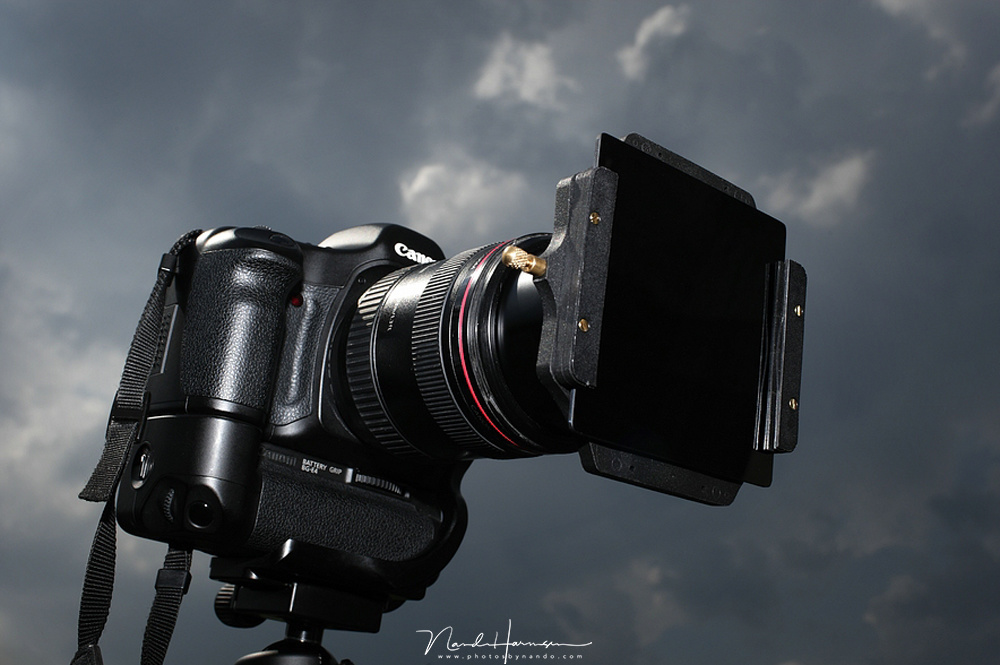
The original Lee Big Stopper, the first 10 stop Neutral Density filter that makes a 1000 times longer shutter times possible.
Today there are even darker ND filter available, that can reduce light up to 32000 times. With such a filter you can use a shutter time up to 17 minutes under a sunny cloudless sky at noon.
Unfortunately these neutral density filters can be expensive. If you don’t use these filters on a regular basis it might be too much to invest in. You could try to find a really cheap filter, but the quality can be very poor and the color cast can make post processing very, very difficult. But there is way to imitate the effect of a longer shutter time with the help of software. You just have to take a lot of pictures… and by that I mean, a lot.
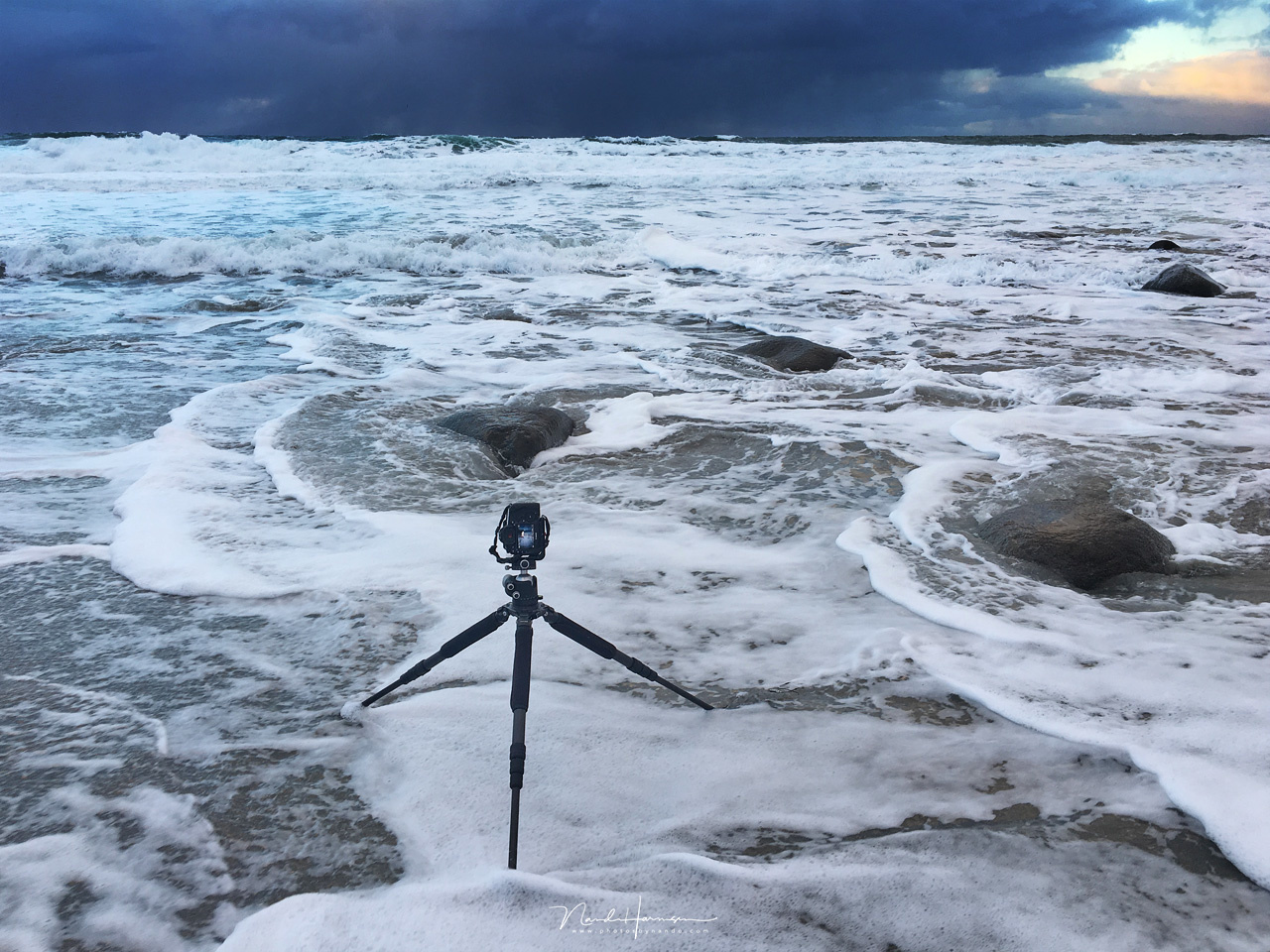
Shooting between the waves at Lofoten in 2019.If you don't have a ND filter, it is possible to simulate a longer exposure by taking a series of images
The technique is quite simple. Determine how long you want your exposure to be, and shoot a series of photos during that wanted exposure time with the slowest shutter speed possible. For example, if you want a photo with exposure time of 30 seconds, and you cannot get below 0.5 seconds with the lowest ISO and smallest aperture, you need to shoot a series of frames of 0.5 seconds during that 30 second time frame. This way you end up with 60 frames. If you want a one minute exposure time, you need to take 120 frames of 0.5 seconds. For a two minutes exposure it will be 240 frames, and so on.
As you can image, a really long exposure simulation will make it necessary to shoot a massive amount of frames. You can make it easy on yourself by activating the time lapse feature of your camera, if present. Or you can set your camera on continues frames and use a remote controller that can be blocked for continue shooting. That way you can let the camera automatically take those frames. You just have to wait.

After importing all images in Lightroom, you can do the post processing you always do. But be careful with Lens profiles. Disable it to prevent strange effects after stacking the images.
Shooting the images is easy. Afterwards you need to add these images into one single photo. The trick I will show makes use of Lightroom and Photoshop. After importing the images from your memory card you must perform exactly the same post-processing to each of the images. Just post process one image, and duplicate the settings (synchronize setting) to all other images of that series. I would recommend to disable any lens corrections because it can result in unwanted effects.
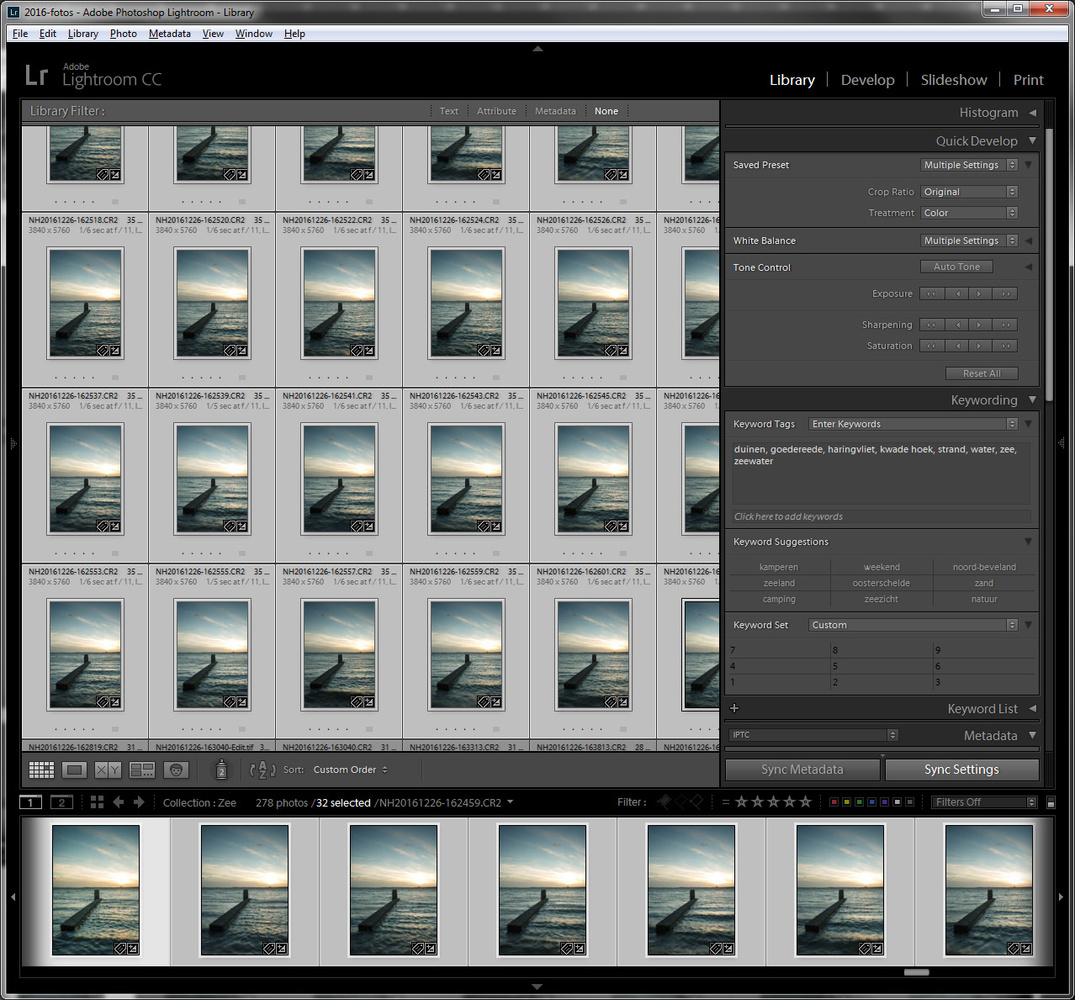
Every image of the series must receive the same post processing. This is made very easy in Lightroom by synchronizing settings.
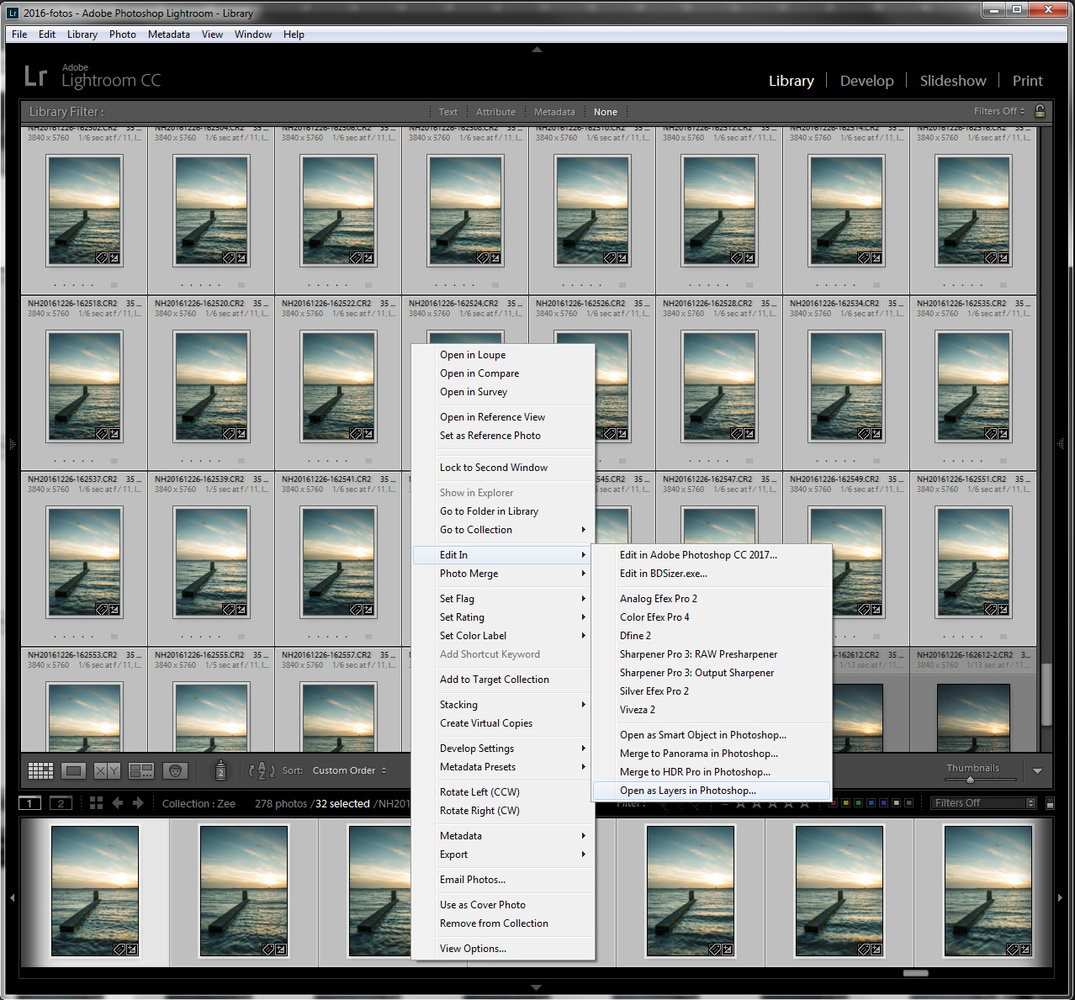
The link between Lightroom and Photoshop makes it easy to load all images into layer in Photoshop by one command in the context menu
Select all images that need to be merged together and open the context menu. Choose Edit In and Open as Layers in Photoshop. Now you have to wait until all images are transferred to Photoshop. How long you need to wait depends on the amount of images, the speed of your computer, and how many megapixels you have per image.
Some advice when the amount of images is very large: split the series of images in two, three, or more parts. Merge these parts separately, and then merge these separate parts into the final picture.

Perhaps it takes a while, but eventually you have all images loaded into layers. If you have too many images, you can divide the amount and repeat the steps.
Now we get to the time consuming steps, so you need to be patient for this. Select all layers in Photoshop and convert these into a Smart Object. If you use a Photoshop version without the Smart Object option, you may select all layers — except the bottom layer — and change the blending mode into Lighten. The result is not the same, but similar.
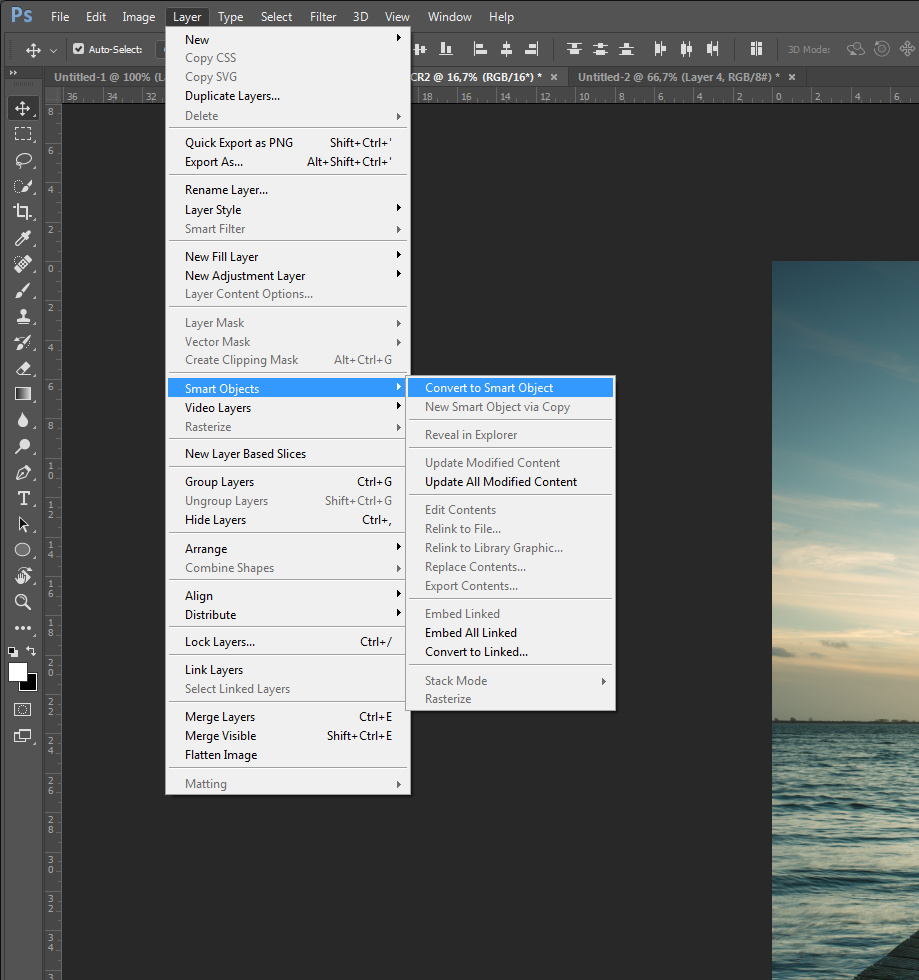
Transform all layers into a Smart Object. This can take a while so grab a coffee during the wait. How long you need to wait depends on the amount of layers, the speed of your computer, and the dimensions of your photos
When the layers are transformed into the Smart Object, open the Layer menu, choose Smart Objects and Stack Mode. From the different stacking options I advise the option Median. After some time the stacking is finished and you can see the result on screen. The final step is to Rasterize the Smart Object, and you’re done.
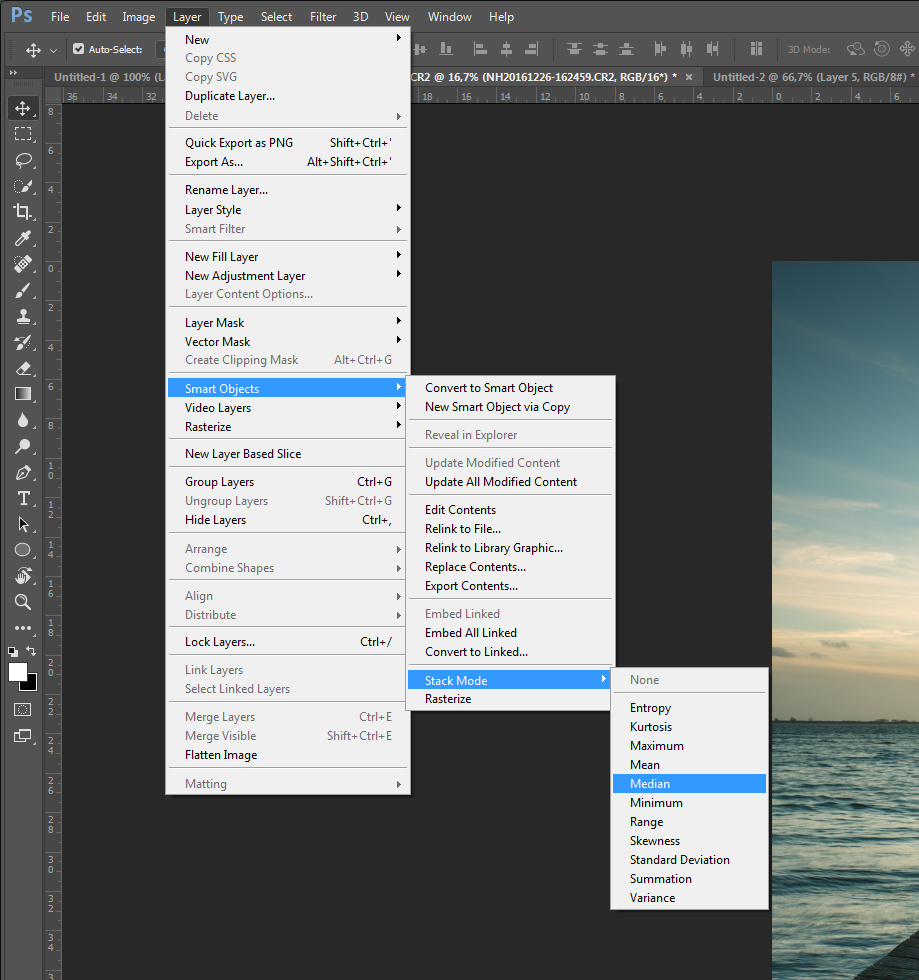
After the Smart Object is made, you can stack the layers in the Smart Object. The best result will be Median stack, but you can experiment with other stacking modes.
For this example I ony used 31 images, each with 1/6 sec exposure time. The end result simulates an exposure time of 5 1/6 sec. If I wanted to simulate a 2 minute exposure, I would need to stack a total of 720 images. The difference between a 5 second stack and a 2 minute exposure can be seen below.
It is not an honest comparison, because of the difference in exposure time. I find the stacking of 31 images doable, but a stack of 700 images is a lot of work, and it would be advisable to do this in parts. It implies this technique is not very user friendly for a massive amount of frames, imitating really long exposures.
Some cameras can automatically stack a couple of photos. Activate the option Multiple Exposure (as it is called on a Canon camera) and choose the maximum amount of images, which is often limited to nine. Use the stacking option Average and you can get an in-camera stacking to simulate a longer exposure.
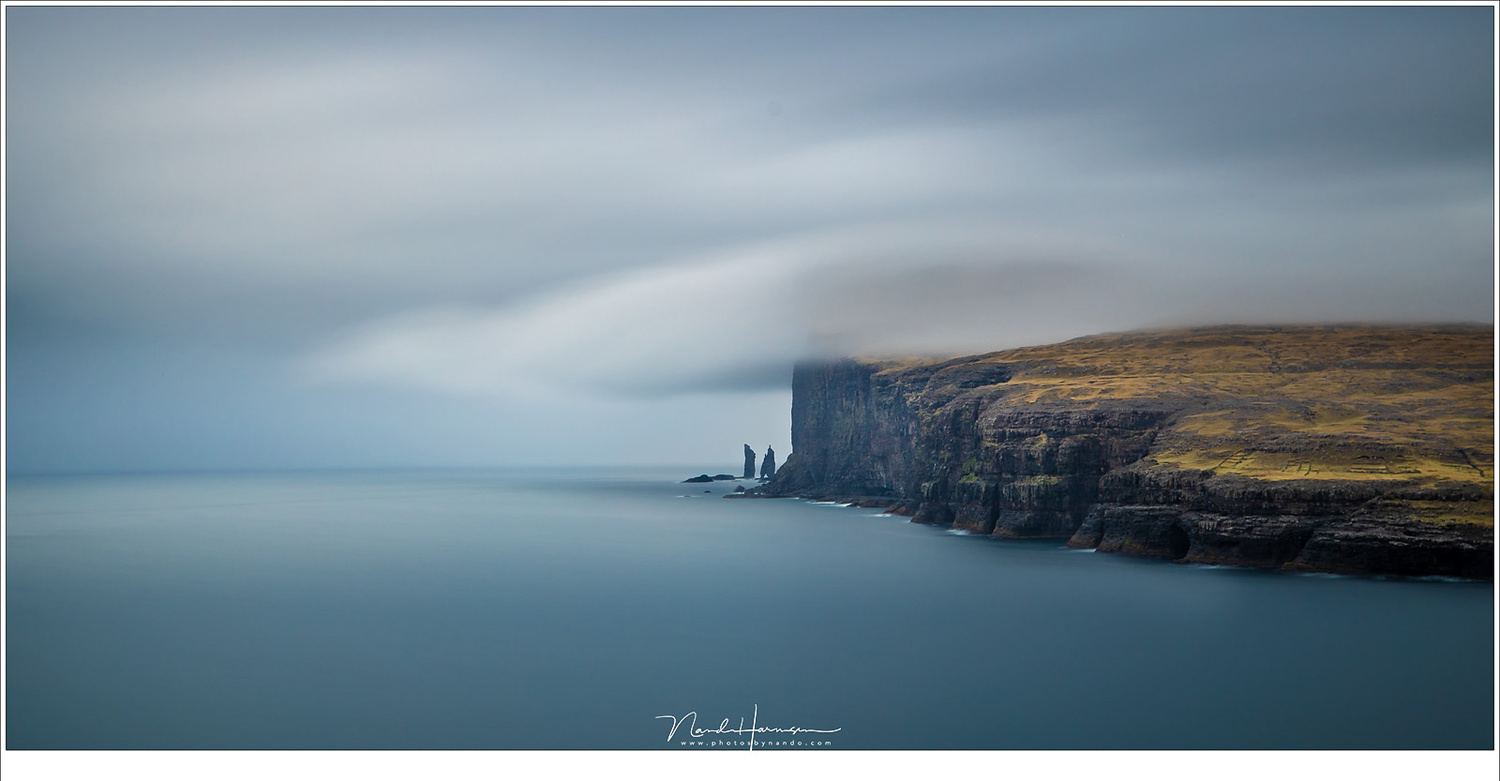
If you like smooth water like this, I strongly advise to invest in a decent ND filter. The stacking technique is just good for an occasional long exposure (EOS 5D4 EF24-70L @ 35mm | ISO200 | f/8 | 120 sec with Lee Big Stopper)
I would advise to invest in a decent neutral density filter if you really like longer exposure photography. But for one time use, stacking is a nice possibility. Have you ever used this technique to stack images? Please let me know in a comment below.



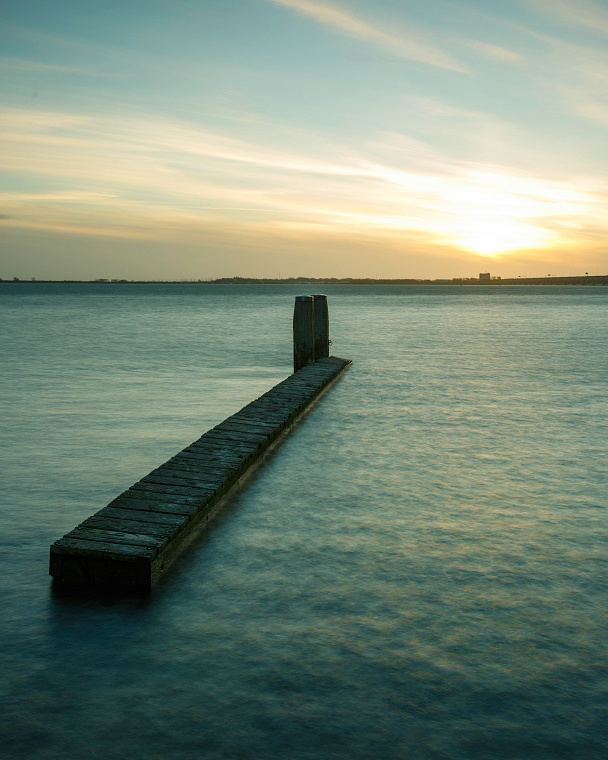
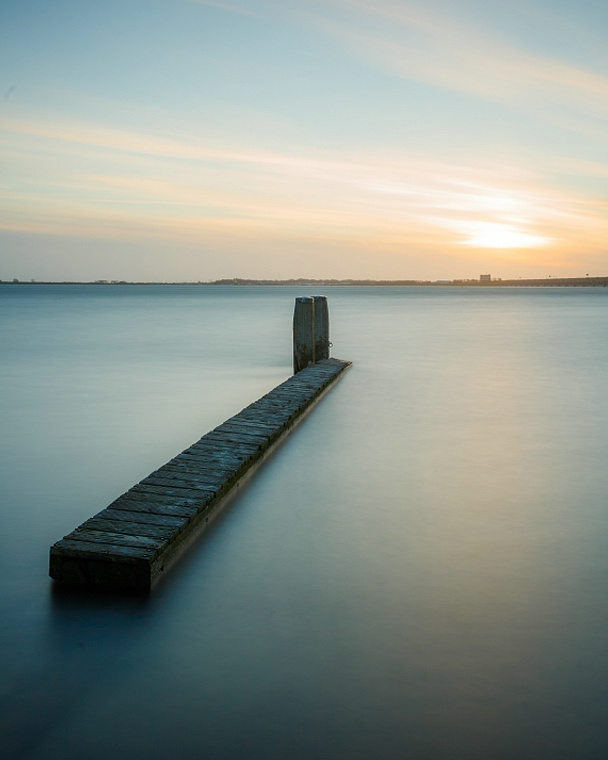






That is really clever, thanks.
I've just bought an ND8 filter and still haven't had much success knowing how best to use it. The issue is visualising the final shot. When I get them onto the computer often they turn out to be boring. I'd hate to spend hours doing dozens of photos only to realise I've created another dud.
You need more than an ND8. 6 stops minimum, 10 stops ideally. ND8 is 3 stops. It'll help but not by much.
Mmm okay but I'm on a budget. No reason why I can't combine the ND8 with multiple exposures.
Indeed. You can use this technique with ND filters. Good luck experimenting with it
All depends on the light situation and the effect you want to have. I shoot a lot with ND8, because it is enough. On other occasion ND64 or ND1000 gives the best exposure time
You can use the same to remove tourists from crowded places
That is also possible. This technique is usable for many effects.
I have used this technique, it is really useful and easy. You see my result on my instagram account...
https://www.instagram.com/p/BkUNxOCnpxa/?utm_source=ig_share_sheet&igshi...
Nice
Why would you want to fire up to 120 shots shortening the shutter life of your camera when with a filter you can do it in one?
Seems like dumb advice to me.
This is a good point Jeff.
I think it would be dumb to let yourself guide by thinking about shutter actuations. Not everyone can spend the money of a good ND filter. And I am pretty sure you will almost never reach the 100,000, 150,000 or 200,000 shutter actuations that is guaranteed by manufacturers.
Depends how often you do long exposures! I shoot then regularly and have never had issues. I used to have a big stopper with a blue colour cast, this was easily removed by setting the Kelvin level for the filter.
You like your way, I prefer mine.
I also prefer using a ND filter of course. But if you like to try long exposures, to see if it is something you would like to do more often, it is a great way. Or when you forgot your filter perhaps.
If many shutter actuations were an issue, many startrail or meteor shooters will run soon into problems. For those images 200, 300 or even more shots are not uncommon.
Anyway. I share your preference. ;)
I use this trick to remove moving people in large public places as churches, square, etc. And also moving cars on the streets :)
Another good use of this technique
I alway do only one shot LE, stacking million of images are a waste of time :P
I guess you have a ND filter... unfortunately not everyone does...
Save up! Give blood! Sell a kidney! Rent out the kids to childless neighbors on weekends. It's an expensive hobby. I suggest Crayons, they're affordable to most who cannot afford an ND filter.
I ready some really stupid crap on here at times, but if you cannot afford an ND filter as an adult, then you have made some piss poor life decisions and should sell the camera and get your ass a better job or an education. Life gets much tougher and you're going to have to budget for things much more expensive than an ND filter. If a working adult cannot afford an ND filter, they should stop wasting time taking photos, they have other REAL LIFE things they should be concentrating on, like getting a job that pays well enough to afford bread, coffee, a danish and A DAMN ND FILTER.
I recommend taking a bracket at f8 and then stopping down to f22 (or whatever your lenses minimum aperture is) and shooting the continuous shots at that f-stop. This means significantly fewer images to deal with in post and less wear on your shutter.
You can then mask in the blurred water/clouds to your sharp image taken at f8.
This is a great technique for when you stumble upon a great landscape/unique lighting event you didn't expect to shoot. I always carry a tabletop tripod in my shoulder bag just in case but my filter kit is a bit too big and cumbersome for that.
I'm using this option from time to time since a long time. Especially if I'm not able to do a really long exposure, because of wind or camera shake for example. Usually between 20-30 pictures. This is one of the pictures I created with this method: https://www.instagram.com/p/BrLVxdXn0rQ/
Looking great
Ive seen this trick before, and while it is definitely handy if you forgot your filters at home, I cannot see it as reliable workaround if you shoot long exposures often. Reason being, this seems like a great way to not only require a huge amount of data (240 images for a 2-minute exposure!), but it seems like an unnecessary wear on your shutter count. I shoot long exposures a lot, sometimes take several shots at the same location. I cannot imagine shooting 2-3 thousand photos every time I am out.
I agree it is just for a single time. I wouldn't worry too much about shuttercount. If that would be a problem, people that shoot startrails would be get into problems. They shoot as many as 200 up to 400 shots per image. I have done this for years, and I never had any problems. You have to do your best to reach 100.000 or more shutter actuations.
A ND filter is the better way.
Definitely agreed with you, shutter actuations isnt the biggest of issues, but still something I keep in mind. The sheer amount of data used for these kinds of shots is a bit off-putting for me. If I can get it in 1-2 shots, that sounds more appealing to me. Of course, this isnt always possible, especially when shooting startrails
Indeed... there is a lot of data involved. I definitely would recommend a ND filter. :)
The money I'd have to spend on a computer to process this, not to mention memory cards to store all those photos would go towards a really nice ND filter.
Is your computer that slow? The only investment is computer time, not the computer itself. You just have to wait for the computer to do the work, while watching a film, or reading a book, or learning a language... ;)
Fair enough. I was just being a cheeky bastard. Its a nice method nonetheless.
Very slick!! Thanks for sharing this trick
Great article, and it give me an idea -- how about in-camera multiple exposures? Hmmm . . . Have to give that a shot . . .
Often in-camera multiple exposures are limited to nine. At least with the Nikon D850 and with Canon EOS 5D4 and sibbelings. If you can use it with 5 second exposures you should get a decent long exposure in-camera.
This technique does not replace long exposure. Long exposures will add the moving components together so waves will appear milky. Multiple exposures will subtract so that fixed components behind the waves will appear to be sharp and without noise whilst waves will appear as multiple ghostly wisps that merge better with more exposures.
Perhaps you should try it yourself and see the result. You will see the result is similar.
Many of my pictures are made of multiple frames blended together, even though they are not worth showing.
For what reason have you blended multiple frames? Is it for HDR, or for noise cancellation, or for another reason?
Mainly to kill noise. Also to impart a dreamy, ephemeral look. Sea waves are flattened and the spray becomes translucent whilst rocks are well defined down to the depth that they are uncovered at some stage in the wave cycle. The same method is excellent for ridding a picture of pesky tourists and clouds that move across peaks. I have tried this, without any success yet, to show impossible lighting of various components within a single resultant picture.
Since all the frames are taken at the same exposure there is no improvement in the dynamic range. There may be a little improvement in detail and colour depth shown but I have not managed to do this convincingly. there are various techniques for this that can be found on the Internet. Astro-photography sites seem to be the best.
I see. That is what others use dark ND filters for :)
Nando, thank you for this article.
You're welcome
Thanks for your very interesting article. I think taking picture series is a very good alternative to ND filters and one can take it even some steps further.
Almost every camera can record one thing these days: movies! And movies are nothing else than picture series. Consider also the thousands of free movies already existing.
I have written two small programs in Python that do the following things:
1. Extract picture series from movies.
2. Aggregate the pictures to one picture. An ND filter is mathematically just an average. But there are more possibilities.
I'm creating several such projects at the moment and am looking forward to the response when I publish them soon.